1996 PONTIAC BONNEVILLE engine oil
[x] Cancel search: engine oilPage 260 of 387
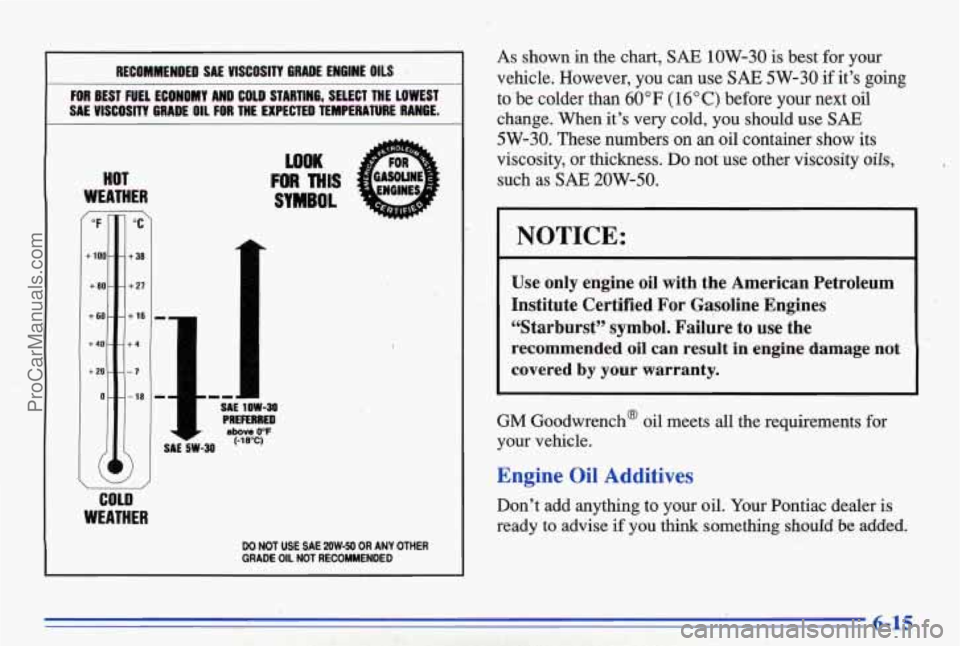
I RECOMMENDED SAE VISCOSITY GRADE ENGINE OILS 1
FOR BEST FUEL ECONOMY AND COLD STARTING, SELECT THE LOWEST
I SAE VISCOSITY GRADE OIL FOR THE EXPECTED TEMPERATURE RANGE.
HOT
WEATHER
/
COLD
I WEATHER
SAE 5W-30
WOK
FOR THIS 4
SYMBOL
SAE 10W-30 PREFEMEO abow (PF (-18°C)
DO NOT USE SAE MW-50 OR ANY OTHER GRADE OIL NOT RECOMMENDED
As shown.in the chart, SAE 1OW-30 is best for your
vehicle. However,
you can use SAE 5W-30 if it’s going
to be colder than 60 OF (1 6 O C) before your next oil
change. When it’s very cold, you should use
SAE
5W-30. These numbers on an oil container show its
viscosity, or thickness. Do not use other viscosity
oils,
such as SAE 20W-50.
NOTICE:
Use only engine oil with the American Petroleum
Institute Certified For Gasoline Engines
“Starburst” symbol. Failure to use the
recommended oil can result in engine damage
not
covered by your warranty.
GM Goodwrench@ oil meets all the requirements for
your vehicle.
Engine Oil Additives
Don’t add anything to your oil. Your Pontiac dealer is
ready to advise if you
think something should be added.
6-15
ProCarManuals.com
Page 261 of 387
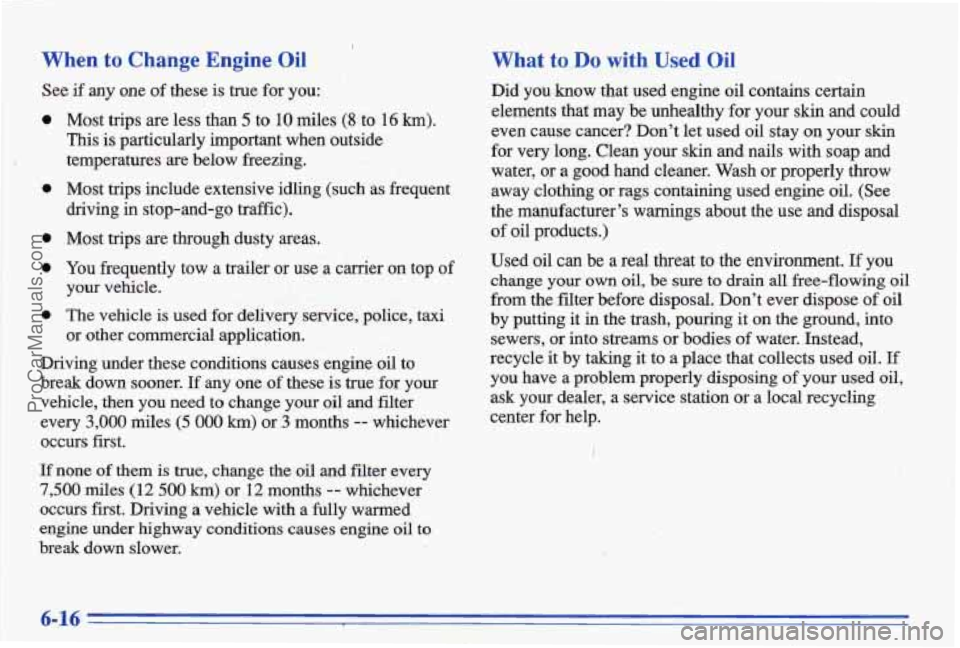
a
a
a
a
a
Most trips are less than 5 to 10 miles (8 to 16 km).
This is particularly important when outside
temperatures are below freezing.
Most trips include extensive idling (such as frequent
driving in stop-and-go traffic).
Most trips are through dusty areas.
You frequently tow a
trailer or use a carrier on top of
your vehicle.
The vehicle
is used for delivery service, police, taxi
or other commercial application.
Driving under these conditions causes engine oil
to
break down sooner. If any one of these is true for your
vehicle, then you need to change
your oil and filter
every
3,000 miles (5 000 km) or ,3 months -- whichever
occurs first.
If none of them is true, change the oil and filter every
7,500 miles (12 500 km) or 12 months -- whichever
occurs fiist. Driving a vehicle with
a fully warmeld
engine under highway conditions causes engine oil to
break down slower.
What to Do with Used Oil
Did you know that used engine oil contains certain
elements that may be
unhealthy -for your skin and could
even cause cancer? Don’t let used oil stay on
your skin
for very long. Clean your skin and nails with soap and
water, or a good hand cleaner. Wash or properly throw
away clothing or rags containing used engine
oil. (See
the manufacturer’s warnings .about the use and disposal
of oil products.)
Used
oil can be a real threat to the environment. If you
change your own oil, be sure to drain all free-flowing oil
from the filter before disposal. Don’t ever dispose of oil
by putting it in the trash, pouring it on the ground, into
sewers, or into streams or bodies
of water. Instead,
recycle it by taking it to
a place that collects used oil. If
you have a problem properly disposing of
you used oil,
ask your dealer, a service station or a local recycling
center for help.
I
6-16
ProCarManuals.com
Page 264 of 387
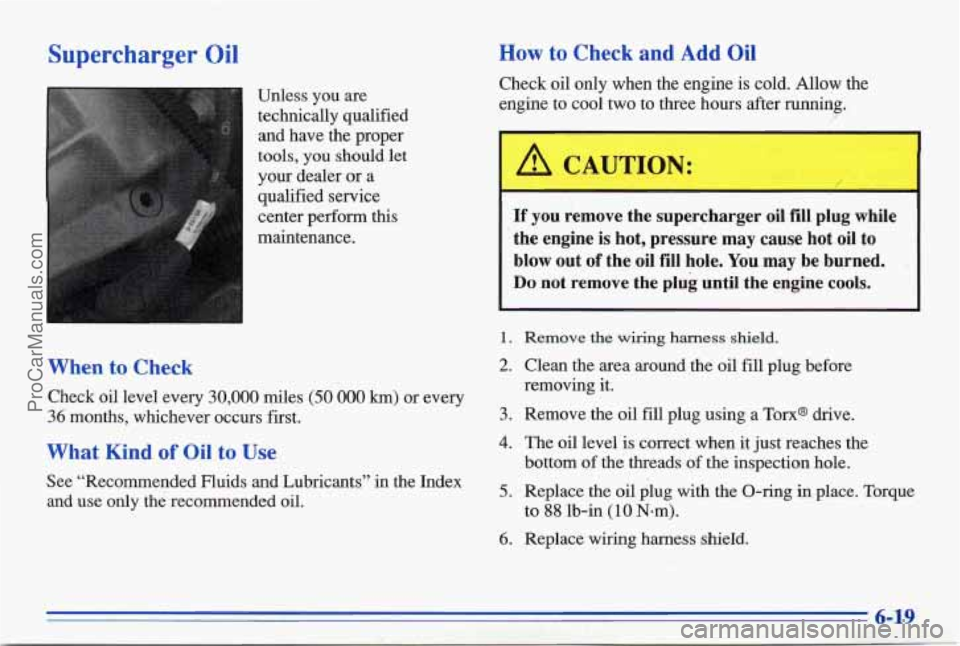
Supercharger Oil
Unless you are
technically qualified and have the proper
tools, you should let
your dealer or a
qualified service
center perform this
maintenance.
When to Check
Check oil level every 30,000 miles (50 000 km) or every
36 months, whichever occurs ,first.
What Kind of Oil to Use
See “Recommended Fluids and Lubricants” in the Index
and use only the recommended oil.
How to Check and Add Oil
Check oil only when the engine is cold. Allow the
engine to cool two to three hours after running.
If you remove the supercharger oil fill plug while
the engine
is hot, pressure may cause hot oil to
blow out
of the oil fill hole. You may be burned.
Do not remove the plug until the engine cools.
1. Remove the wiring harness shield.
2. Clean the area around the oil fill plug before
removing it.
3. Remove the oil fill plug using a Torx@ drive.
4. The oil level is correct when it just reaches the
bottom of the threads of the inspection hole.
5. Replace the oil plug with the O-ring in place. Torque
6. Replace wiring harness shield. to
88 lb-in (10 N-m).
ProCarManuals.com
Page 265 of 387
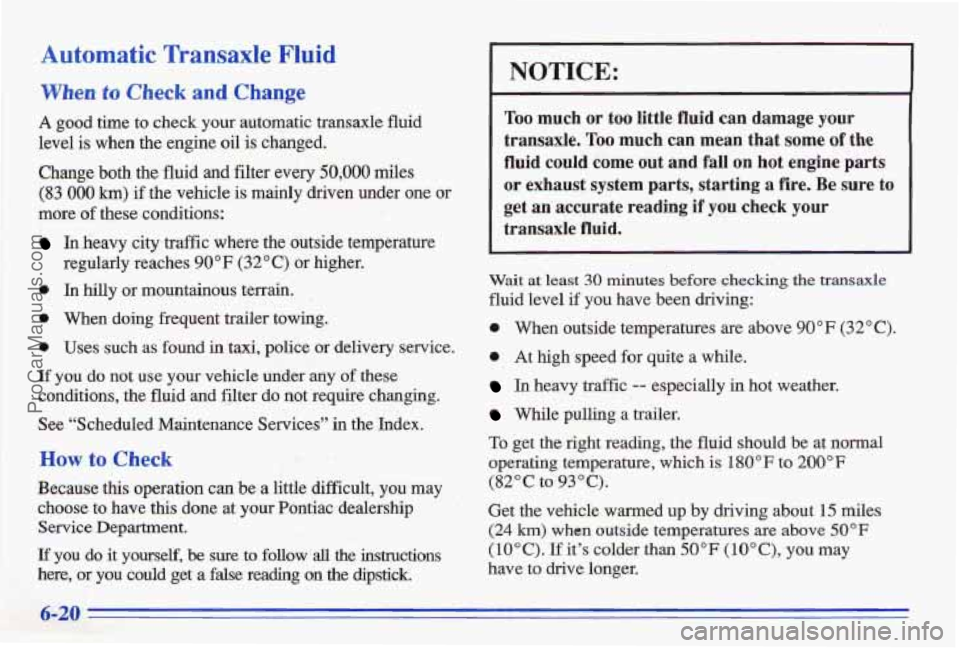
Automatic Transaxle Fluid
When to Check and Change
A good time to check your automatic transaxle fluid
level is when the engine oil
is changed.
Change both the fluid
and filter every 50,000 miles
(83 000 km) if the vehicle is mainly driven under one or
more of these conditions:
In .heavy eity.traffic where the 'outside temperature
regularly reaches
90 OF (32 O C) or higher.
0 In hilly or mountainous terrain.
0 When doing frequent trailer towing.
0 Uses such as found in taxi, police or delivery service.
If you do not use your vehicle under any of these
conditions, the fluid and filter
do not require changing.
See "Scheduled Maintenance Services"
in the Index.
..
I .(.. :.-'Bow to Check
Because &is operation can be a little dBicult, you may
choose to have
this done at your P'ontiac dealership
Service Department.
If you do it yourself, be' sure to follow all the instructions
here, or you could get a false reading on the dipstick.
NOTICE:
Too much or too little fluid can damage your
transaxle.
Too much can mean that some of the
~ fluid could come out and fall on hot engine parts
or exhaust system parts, starting
a fire. Be sure to
get an' accurate reading if you check your
transaxle fluid.
Wait at least 30 minutes before checking.& .@an: Je
fluid level if you have been driving:
0 When outside temperatures are above 90°F (32°C).
0 At high speed for quite a while.
In heavy traffic -- especially in hot weather.
While pulling a trailer.
To get the right reading, the fluid should be at normal
operating temperature, which is
180°F to 200°F
(82°C to 93°C).
Get the vehicle warmed up by driving about 15 miles
(24 km) when outside temperatures are above 50°F
(10°C). If it's colder than 50°F (lO"C), you may
have
to drive longer.
ProCarManuals.com
Page 266 of 387
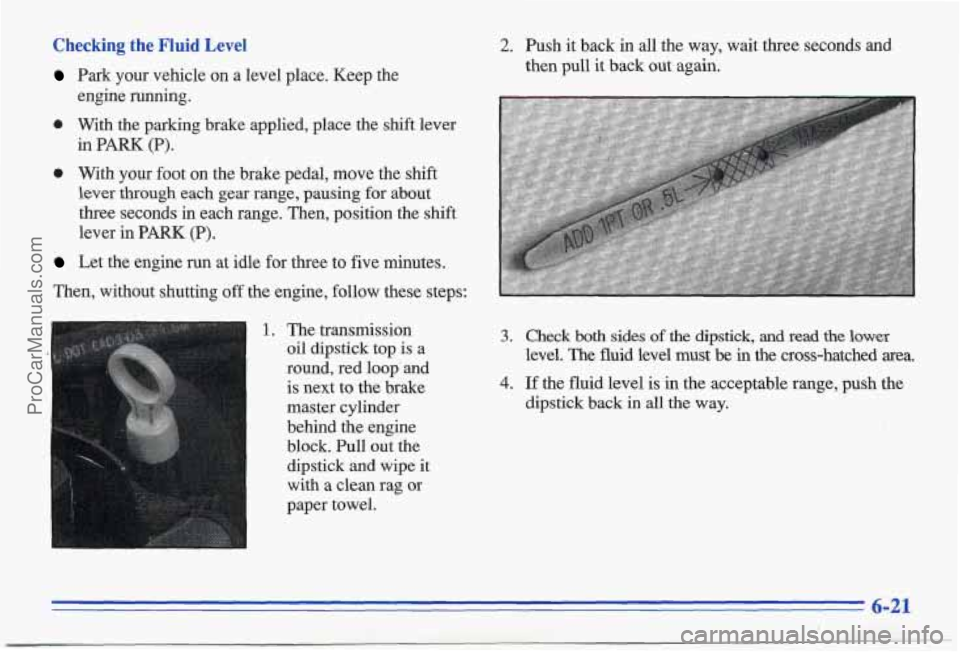
Checking the Fluid Level
Park your vehicle on a level place. Keep the
0 With the parking brake applied, place the shift lever
engine running.
in
PARK (P).
0 With your foot on the brake pedal, move the shift lever through each gear range, pausing
for about
three seconds
in each range. Then, position the shift
lever in
PARK (P).
Let the engine run at idle for three to five minutes.
Then, without shutting
off the engine, follow these steps:
I. The transhission
oil dipstick top is a
round, red loop' and
is next to the brake
master cylinder
behind the engine
dipstick and wipe it
with a clean rag
or
paper towel.
i block. Pull out the
2. Push it back in all the way, wait three seconds and
then pull it back out again.
3.
4.
Check both sides of the dipstick, and read the lower
level. The fluid level must be in the cross-hatched area.
If the fluid level is in the acceptable range, push the
dipstick back in all the way.
6-21
ProCarManuals.com
Page 267 of 387
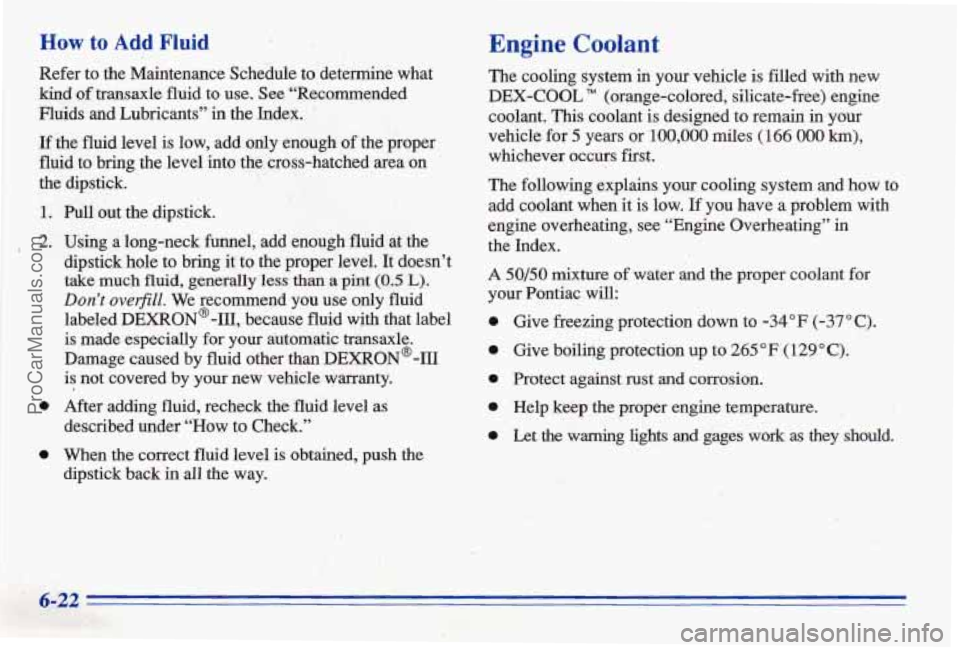
How to Add Fluid
Refer to the Maintenance Schedule to determine what
bind of tmhsaxle fluid to use. See 6‘Recomended
Fluids and Lubricants” in the Index.
If the fluid level is low, add only enough of the proper
fluid to bring
the level into the cross-hatched area on
the dipstick.
Pull out the dipstick.
Using a long-neck funnel, add enough
Md at the
dipstick hole to bring it to the proper level. It doesn’t
take much
fluid, generally less than a pint (0.5 L).
Don’t overfiI2. We recommend you use only fluid
labeled
DEXRON*-III,, because fluid with that label
is made especially for yo& automatic transax18e.
Damage caused
by fluid other than DEXRON’@-III
is not covered by your new vehicle warranty.
After adding fluid, recheck the fluid level as
described under “How to Check.”
When the correct fluid level is obtained, push the
dipstick back in
all the way.
Engine Coolant
The cooling system in your vehicle is filled with new
DEX-COOL (orange-colored,
silicate-free) engine
coolant.
This coolant is designed to remain in your
vehicle for 5 years or 100,000 miles (166 000 km),
whichever occurs first.
The following explains your cooling system and how to
add coolant when it is low.
If you have a problem with
engine overheating, see “Engine Overheating” in
the Index.
A 50/50 mixture of water &d the proper coolant for
your Pontiac will:
e
e
0
0
0
Give freezing protection down to -34°F (-37°C).
Give boiling protection up to 265 OF (1 29 O C).
Protect against rust and corrosion.
Help keep the proper engine temperature.
Let the warning lights and gages work as they should.
ProCarManuals.com
Page 268 of 387
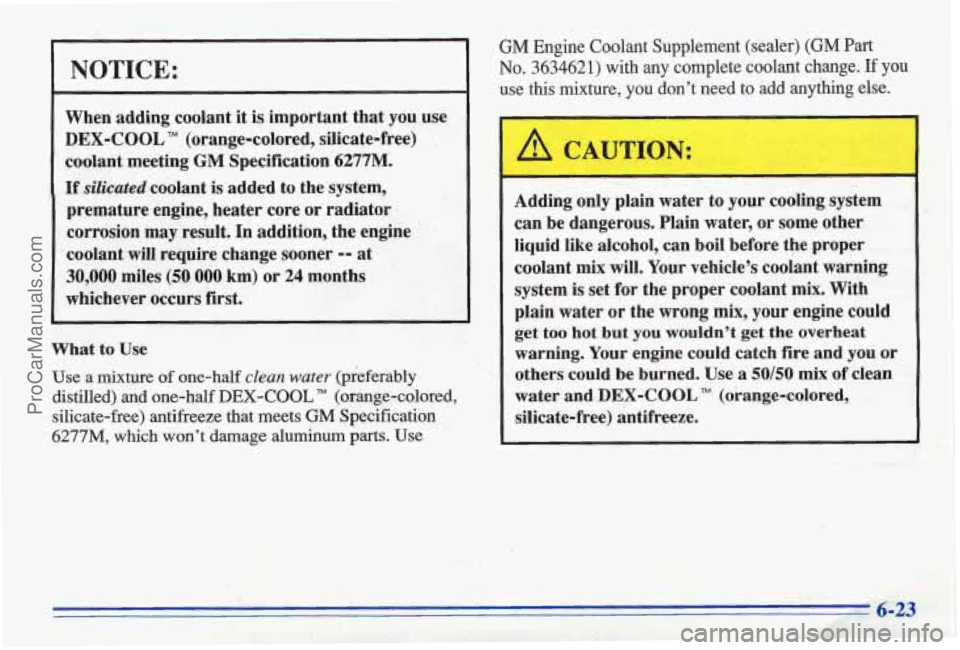
NOTICE:
When adding coolant it is important that you use
DEX-COOL TM (orange-colored, silicate-free)
coolant meeting
GM Specification 6277M.
If silicated coolant is added to the system,
premature engine, heater core or radiator
corrosion may result. In addition, the engine
’ ‘ .
-coolant will require change sooner -- at
308,000 miles (50 000 km) or 24 months
whichever occurs first.
What to Use
Use a mixture of one-half clean water (preferably
distilled) and one-half
DEX-COOL (orange-colored,
silicate-free) antifreeze that meets
GM Specification
6277M, which won’t damage aluminum parts. Use
GM Engine Coolant Supplement (sealer) (GM Part
No. 3634621) with any complete coolant change. If you
use this mixture, you don’t need to
add anything else.
L
Adding only plain water to your cooling system
can be dangerous. Plain water,
or some other
liquid like alcohol, can boil before the proper
coolant mix will. Your vehicle’s coolant warning
system is set for the proper coolant mix. With
plain water
or the wrong mix, your engine could
get too hot but you wouldn’t get
the overheat
warning. Your engine could catch fire and you or
others could
be burned. Use a 5060 mix of clean
water and
DEX-COOL TM (orange-colored,
silicate-free) antifreeze.
ProCarManuals.com
Page 275 of 387
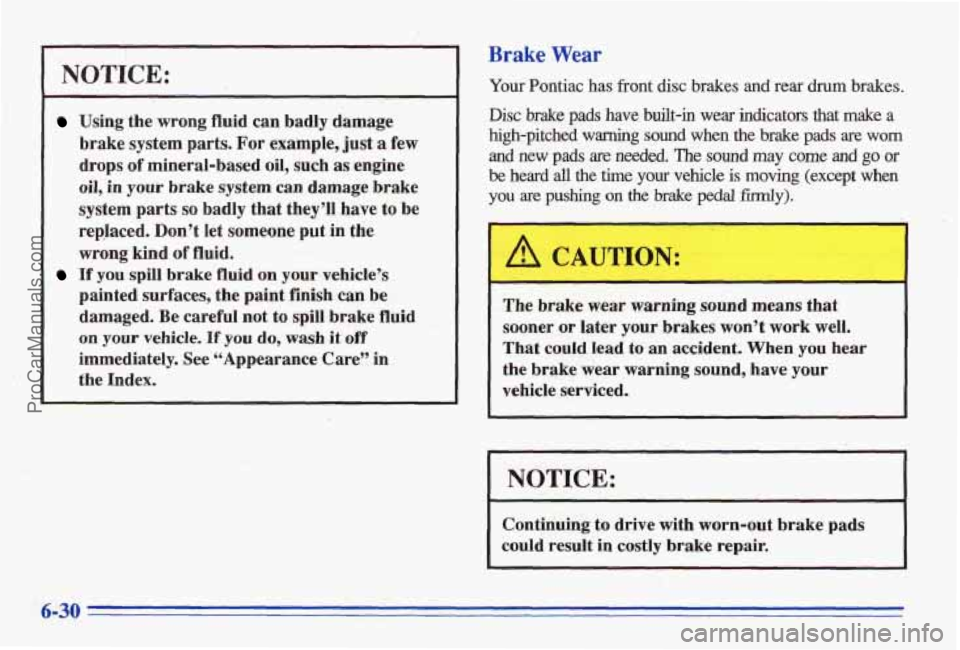
NOTICE:
Using the wrong fluid can badly damage
brake system parts. For example, just
a few
drops of mineral-based oil, such as engine
oi1,’in
your brake system can damage brake
system parts
so badly that they’ll have to be
rep,laced. Don’t let someone put in the
wrong kind
of fluid.
If you spill brake fluid on your vehicle’s
painted surfaces, the paint finish can be
damaged. Be careful not to spill
brake fluid
on your vehicle. If you do, wash it off
immediately. See “Appearance Care” in
the Index.
Brake Wear
Your Pontiac has front disc brakes and rear drum brakes.
Disc brake pads have built-in wear indicators that make a
high-pitched
warning sound when the brake pads are worn
and
new pads are needed. The sound may come and go or
be heard all the time you vehicle is moving (except when
you are pushing on the brake pedal firmly).
I A CAUTION:
The brake wear warning sound means that
sooner
or later your brakes won’t work well.
That
could lead to an accident. When you hear
the brake wear warning sound, have your
vehicle
serviced.
I NOTICE:
Continuing to drive with worn-out brake pads
could result in costly brake repair.
6-30
ProCarManuals.com